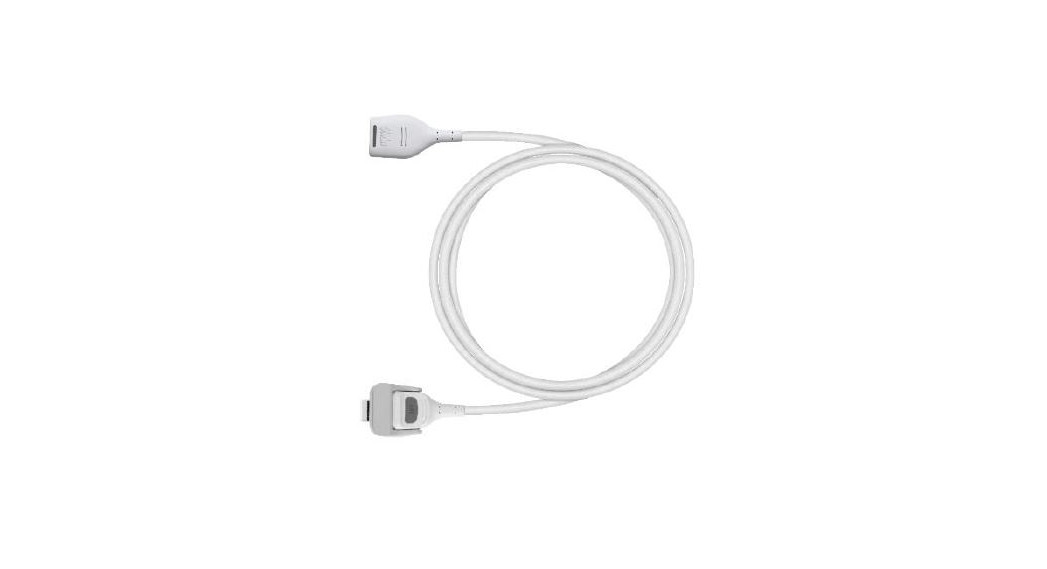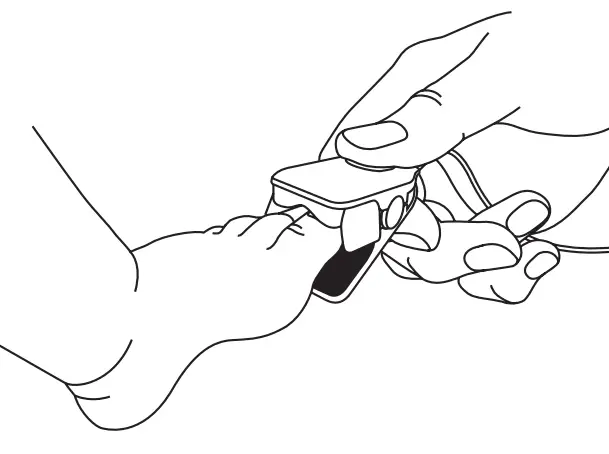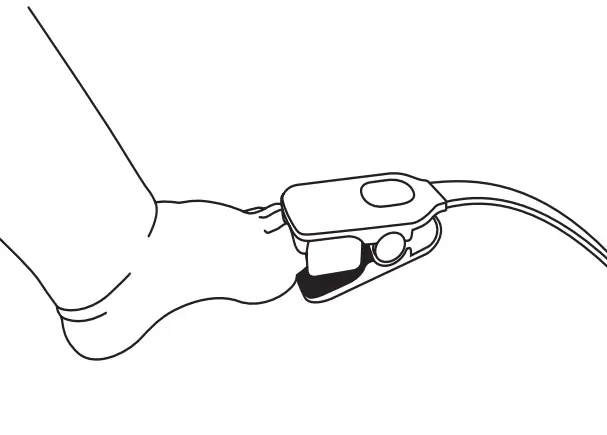 Rad-G™Reusable Finger Clip Sensor
Rad-G™Reusable Finger Clip Sensor
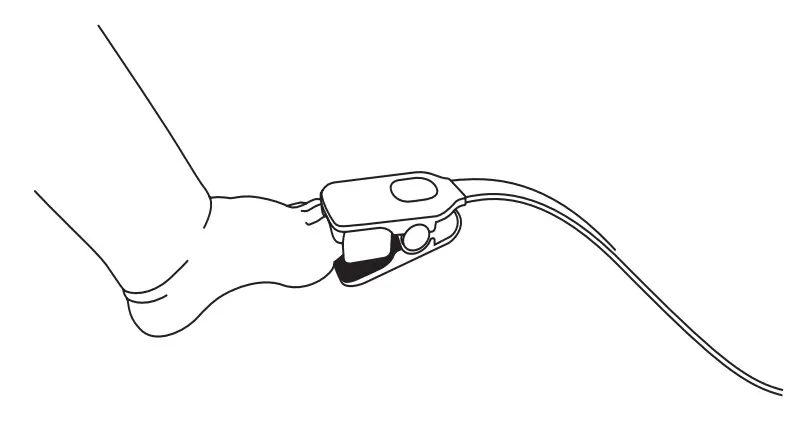 |
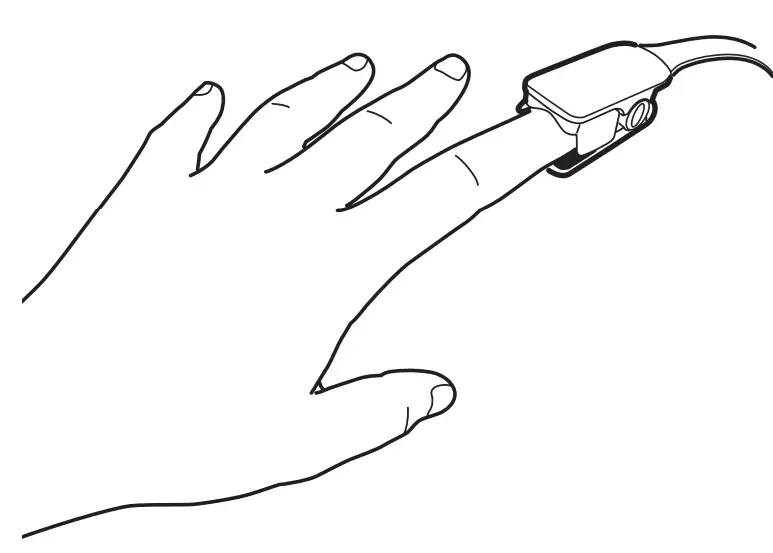 |
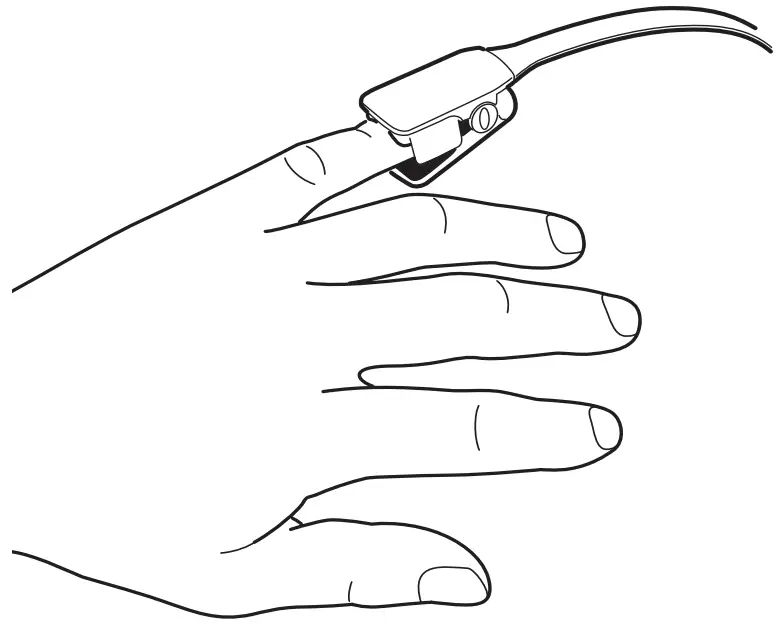 |
Rad-G™Reusable Finger Clip Sensor
| FIG: 1
|
 |
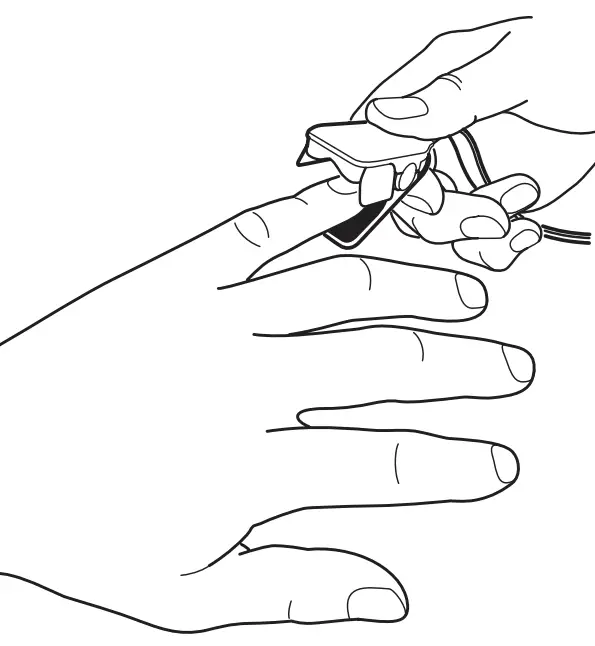 |
| FIG:2
|
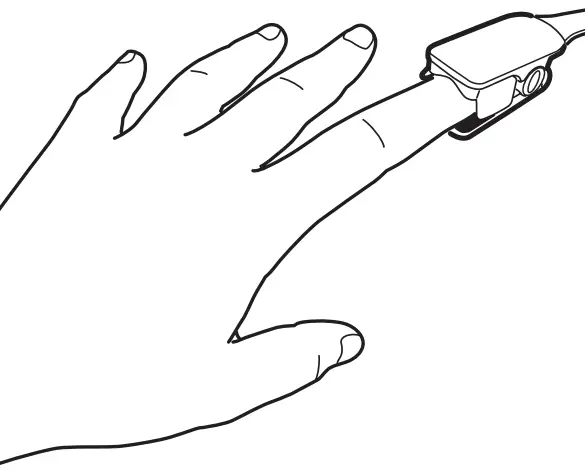 |
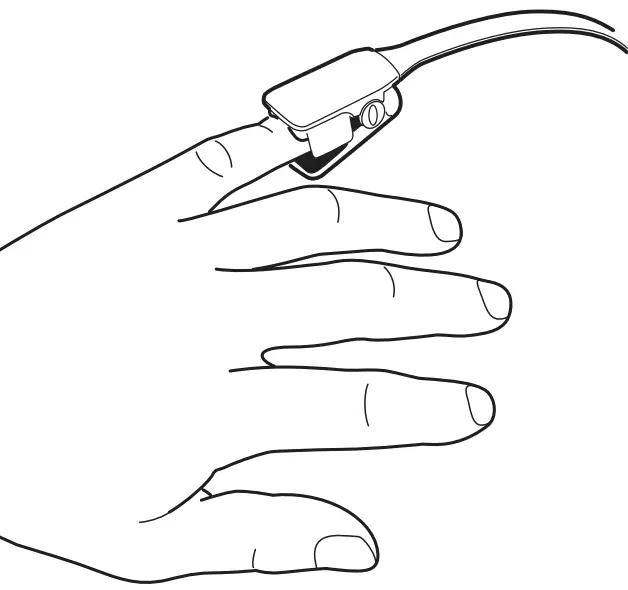 |
DIRECTIONS FOR USEReusable![]() Not made with natural rubber latex
Not made with natural rubber latex![]()
![]()
![]()
INDICATIONS
The Rad-G™ reusable sensors are indicated for noninvasive spot-checking of functional oxygen saturation of arterial hemoglobin (SpO2) and pulse rate (measured by a SpO2 sensor) for use with adult, pediatric, and infant patients during both no motion and motion conditions, and for patients who are well or poorly perfused in hospitals, hospital-type facilities, mobile, and home environments.
CONTRAINDICATIONS
The Rad-G reusable sensors are contraindicated for use on mobile patients or for prolonged periods of use. They are not intended for long-term monitoring. They must be removed and repositioned to a different monitoring site at least every four (4) hours. Because individual skin conditions and perfusion levels affect the ability of the site to tolerate sensor placement, it may be necessary to move the sensor more frequently.
DESCRIPTION
The Rad-G reusable sensors are for use only with Rad-G devices containing Masimo SET® oximetry and licensed to use Rad-G sensors.The Rad-G sensor is only compatible with the Rad-G device.The Rad-G sensors have been verified with Masimo SET Oximetry Technology.WARNING: Masimo sensors and cables are designed for use with devices containing Masimo SET oximetry or licensed to use Masimo sensors.
WARNINGS, CAUTIONS, AND NOTES
- All sensors and cables are designed for use with specific monitors. Verify the compatibility of the monitor, cable, and sensor before use, otherwise degraded performance and/or patient injury can result.
- The sensor should be free of visible defects, discoloration and damage. If the sensor is discolored or damaged, discontinue use. Never use a damaged sensor or one with exposed electrical circuitry.
- The site must be checked frequently or per clinical protocol to ensure adequate circulation, skin integrity, and correct optical alignment.
- Exercise extreme caution; skin erosion, tissue ischemia, and/or pressure necrosis can be caused when the sensor is not frequently moved, applied too tightly, or becomes too tight due to edema. Assess site as frequently as every (1) hour and move the sensor if there are signs of loss of skin integrity and/or loss of circulation or perfusion.
- Do not use tape to secure the sensor to the site; this can restrict blood flow and cause inaccurate readings. The use of tape can cause skin damage, and/or pressure necrosis or damage the sensor.
- Carefully route sensor and patient cable to reduce the possibility of patient entanglement or strangulation.
- Misapplied sensors or sensors that become partially dislodged may cause incorrect readings.
- Misapplications due to wrong sensor types can cause inaccurate or no readings.
- Inaccurate readings may be caused by abnormal venous pulsation or venous congestion.
- Venous congestion may cause by the reading of actual arterial oxygen saturation. Therefore, assure proper venous outflow from the monitored site. The sensor should not be below heart level (e.g. sensor on hand of a patient in a bed with an arm dangling to the floor).
- Venous pulsations may cause erroneous low readings (e.g. tricuspid valve regurgitation, Trendelenburg position).
- The pulsations from intra-aortic balloon support can affect the pulse rate displayed on the oximeter. Verify the patient’s pulse rate against the ECG heart rate.
- Avoid placing the sensor on an extremity with an arterial catheter or blood pressure cuff.
- If using pulse oximetry during full body irradiation, keep the sensor out of the radiation field. If the sensor is exposed to the radiation, the reading might be inaccurate or not provided for the duration of the active radiation.
- If using pulse oximetry during full body irradiation, keep the sensor out of the radiation field. If the sensor is exposed to the radiation, the reading might be inaccurate or the unit might read zero for the duration of the active radiation period.
- Do not use the sensor during MRI scanning or in an MRI environment as it may result in physical harm.
- High ambient light sources such as surgical lights (especially those with a xenon light source), bilirubin lamps, fluorescent lights, infrared heating lamps, and direct sunlight can interfere with the performance of the sensor.
- To prevent interference from ambient light, ensure that the sensor is properly applied, and cover the sensor site with opaque material if required. Failure to take this precaution in high ambient light conditions may result in inaccurate measurements.
- Inaccurate readings may be caused by EMI radiation interference.
- Abnormal fingers, Intravascular dyes such as indocyanine green or methylene blue, or externally applied coloring and texture such as nail polish, acrylic nails, glitter, etc. may lead to inaccurate or no readings.
- High levels of COHb or MetHb may occur with a seemingly normal SpO2. When elevated levels of COHb or MetHb are suspected, laboratory analysis (CO-Oximetry) of a blood sample should be performed.
- Elevated levels of Carboxyhemoglobin (COHb) may lead to inaccurate readings.
- Elevated levels of Methemoglobin (MetHb) may lead to inaccurate readings.
- Elevated levels of total bilirubin may lead to inaccurate readings.
- Inaccurate readings may be caused by severe anemia, very low arterial perfusion, or extreme motion artifact.
- Hemoglobinopathies and synthesis disorders such as thalassemias, Hb s, Hb c, sickle cell, etc. may cause inaccurate readings.
- Inaccurate readings may be caused by vasospastic diseases such as Raynaud’s, and peripheral vascular disease.
- Inaccurate readings may be caused by elevated levels of dyshemoglobin, hypercapnic or hypercapnic conditions, and severe vasoconstriction or hypothermia.
- Readings may be affected under very low perfusion conditions at the monitored site.
- Readings provided with a low signal confidence indicator may not be accurate.
- Do not modify or alter the sensor in any way. Alteration or modification may affect performance and/or accuracy.
- Clean the sensors prior to reuse on multiple patients.
- Do not use undiluted bleach (5% – 5.25% sodium hypochlorite) or any cleaning solution other than those recommended here because permanent damage to the sensor may occur.
- To prevent damage, do not soak or immerse the sensor in any liquid solution.
- Do not attempt to sterilize by irradiation, steam, autoclave or ethylene oxide as it will damage the sensor.
- Do not attempt to reprocess, recondition or recycle Masimo sensors or patient cables as these processes may damage the electrical components, potentially leading to patient harm.
- Caution: Replace the sensor when a replace sensor message is displayed, or when a low SIQ message is consistently displayed while monitoring consecutive patients after completing the low SIQ troubleshooting steps identified in the monitoring device operator’s manual.
- Note: The sensor is provided with X-Cal® technology to minimize the risk of inaccurate readings and unanticipated loss of patient monitoring.The sensor will provide up to 8,760 hours of patient monitoring time. Replace the sensor when the patient monitoring time is exhausted.
INSTRUCTIONS
A) Site Selection
- Choose a site that is well perfused and least restricts a conscious patient’s movements.
- Always choose a size that will completely cover the sensor’s detector window.
- The site should be cleaned of debris prior to sensor placement.
- Select a digit without long fingernails.
CAUTION: Before using the sensor, ensure that the sensor is physically intact, with no broken or frayed wires or damaged parts.Preferred Site By Weight Range
- 3 – 10 kg (Infant)- The preferred site is the Great toe. Alternatively, either thumb can be used.
- 10-50 kg (Pediatric)- The preferred site is the finger of the non-dominant hand; however, the other digits can be used.
- > 30 kg (Adult)- The preferred site is the 5th digit of the non-dominant hand; however, the other digits can be used.
B) Connecting the Sensor to the Device
- Insert the sensor connector into the top of the device.
- Push the connector cover closed until a tactile or audible click of connection is heard.
- Ensure the connector is fully engaged with the device.
C) Attaching the Sensor to the Patient
- Refer to Fig. 1. Orient the cable away from the sensor site. Open the sensor by pressing on the sensor indentations.
- Refer to Fig. 2. Place the selected digit over the sensor window in the bottom half of the sensor. The fleshiest part of the digit should be covering the detector window. The tip of the finger, thumb, or toe, not the nail, should touch the digit stop on the back of the pad.
- The sensor should be opened enough to evenly distribute the grip pressure of the sensor along the length of the finger. Check the arrangement of the sensor to verify correct positioning. Complete coverage of the detector window is needed to ensure accurate data.
NOTE: The sensor is not intended for use across a child’s hand or foot.D) Removing the Sensor from the Patient
- Open the sensor by pressing on sensor indentations. Remove the sensor from the digit and follow the cleaning instructions.
E) Disconnecting the Sensor from the Device
- Lift up the sensor connector cover and Pull firmly on the Sensor connector to disconnect it from the Device.
NOTE: To avoid damage, pull on the sensor connector, not the cable.
CLEANINGTo clean the sensor:
- Remove the sensor from the patient and disconnect it from the patient cable.
- Wipe the sensor pads and outer surfaces using 70% Isopropyl Alcohol, or Quaternary ammonium chloride solution wipes.
- Wipe twice or until the surfaces are free of any visible residue.
- Dry the sensor thoroughly prior to placement on a patient.
The surfaces of the Rad-G reusable sensor have been tested to be chemically resistant to the following solution(s): Glutaraldehyde, quaternary ammonium chloride, 10% bleach (sodium hypochlorite) to 90%water solution, 70% Isopropyl Alcohol.CAUTIONS
- Do not use undiluted bleach (5% – 5.25% sodium hypochlorite) or any cleaning solution other than those recommended here because permanent damage to the sensor may occur.
- To prevent damage, do not soak or immerse the sensor in any liquid solution.
- Do not sterilize by irradiation, steam, autoclave, or ethylene oxide.
SPECIFICATIONS
When used with Masimo SET pulse oximetry monitors or with licensed Masimo SET pulse oximetry modules, Rad-G reusable sensors have the following specifications:
|
Rad-G Sensor |
Adult | Pediatric |
Infant |
| > 30 kg | 10 – 50 kg | 3-10 kg | |
| Application site | Finger or toe | Finger, thumb, or great toe | Finger, thumb, or great toe |
| Sp02 Accuracy, No Motions | 2% | 2% | 2% |
| Sp02 Accuracy, Motion2 | 3% | 3% | 3% |
| Sp02 Accuracy, Low Perfusion3 | 2% | 2% | 2% |
| Pulse Rated Accuracy, No Motion | 3 bpm | 3 bpm | 3 bpm |
| Pulse Rate Accuracy, Motion | 5 bpm | 5 bpm | 5 bpm |
| Pulse Rate Accuracy, Low Perfusion | 3 bpm | 3 bpm | 3 bpm |
NOTE: Arms accuracy is a statistical calculation of the difference between device measurements and reference measurements. Approximately two-thirds of the devicemeasurements fell within +/- Arms of the reference measurements in a controlled study.1The Masimo SET Technology has been validated for no motion accuracy in human blood studies on healthy adult male and female volunteers with light to darkly pigmented skin in induced hypoxia studies in the range of 70%-100% SpO2 against a laboratory co-oximeter.2 The Masimo SET Technology has been validated for motion accuracy in human blood studies on healthy adult male and female volunteers with light to darkly pigmented skin in induced hypoxia studies while performing rubbing and tapping motions, at 2 to 4 Hz at an amplitude of 1 to 2 cm and a non-repetitive motion between 1 to 5 Hz at an amplitude of 2 to 3 cm in induced hypoxia studies in the range of 70%-100% SpO2 against a laboratory co-oximeter.3The Masimo SET Technology has been validated for low perfusion accuracy in benchtop testing against a Biotek Index 2 simulator and Masimo’s simulator with signal strengths of greater than 0.02% and transmission of greater than 5% for saturations ranging from 70% to 100%.4 The Masimo SET Technology has been validated for pulse rate accuracy for the range of 25-240 bpm in benchtop testing against a Biotek Index 2 simulator and Masimo’s simulator with signal strengths of greater than 0.02% and transmission of greater than 5% for saturations ranging from 70% to 100%.
COMPATIBILITY
This sensor is intended for use only with Rad-G devices containing Masimo SET technology. Each sensor is designed to operate correctly only on the pulse oximetry systems from the original device manufacturer. Use of this sensor with other devices may result in no or improper performance.
WARRANTY
Masimo warrants to the initial buyer only that these products, when used in accordance with the directions provided with the Products by Masimo, will be free of defects in materials and workmanship for a period of six (6) months. Single-use products are warranted for single-patient use only.THE FOREGOING IS THE SOLE AND EXCLUSIVE WARRANTY APPLICABLE TO THE PRODUCTS SOLD BY MASIMO TO BUYERS. MASIMO EXPRESSLY DISCLAIMS ALL OTHER ORAL, EXPRESS, OR IMPLIED WARRANTIES, INCLUDING WITHOUT LIMITATION ANY WARRANTIES OF MERCHANTABILITY OR FITNESS FOR A PARTICULAR PURPOSE. MASIMO’S SOLE OBLIGATION AND BUYER’S EXCLUSIVE REMEDY FOR BREACH OF ANY WARRANTY SHALL BE, AT MASIMO’S OPTION, TO REPAIR OR REPLACE THE PRODUCT.
WARRANTY EXCLUSIONS
This warranty does not extend to any product that has been used in violation of the operating instructions supplied with the product, or has been subject to misuse, neglect, accident or externally created damage. This warranty does not extend to any product that has been connected to any unintended instrument or system, has been modified, or has been disassembled or reassembled. This warranty does not extend to sensors or patient cables that have been reprocessed, reconditioned, or recycled.IN NO EVENT SHALL MASIMO BE LIABLE TO THE BUYER OR ANY OTHER PERSON FOR ANY INCIDENTAL, INDIRECT, SPECIAL, OR CONSEQUENTIAL DAMAGES (INCLUDING WITHOUT LIMITATION LOST PROFITS), EVEN IF ADVISED OF THE POSSIBILITY THEREOF. IN NO EVENT SHALL MASIMO’S LIABILITY ARISING FROM ANY PRODUCTS SOLD TO THE BUYER (UNDER A CONTRACT, WARRANTY, TORT, OR OTHER CLAIM) EXCEED THE AMOUNT PAID BY THE BUYER FOR THE LOT OF PRODUCT(S) INVOLVED IN SUCH CLAIM. IN NO EVENT SHALL MASIMO BE LIABLE FOR ANY DAMAGES ASSOCIATED WITH A PRODUCT THAT HAS BEEN REPROCESSED, RECONDITIONED, OR RECYCLED. THE LIMITATIONS IN THIS SECTION SHALL NOT BE DEEMED TO PRECLUDE ANY LIABILITY THAT, UNDER APPLICABLE PRODUCTS LIABILITY LAW, CANNOT LEGALLY BE PRECLUDED BY CONTRACT.
NO IMPLIED LICENSE
Purchase or possession of this sensor confers no express or implied license to use the sensor with any device which is not separately authorized to use Masimo sensors.For professional use. See instructions for full prescribing information, including indications, contraindications, warnings, precautions, and adverse events.If you encounter any serious incident with the product, please notify the competent authority in your country and the manufacturer.The following symbols may appear on the product or product labeling:
|
SYMBOL |
DEFINITION | SYMBOL | DEFINITION | SYMBOL |
DEFINITION |
| Follow instructions for use | Separate collection for electrical and electronic equipment (WEEE). | Caution: Federal law (USA) restricts this device is to sale by or on the order of a physician | |||
| Consult instructions for use | Lot code | Mark of conformity to European Medical Device Directive 93/42/EEC | |||
|
|
Manufacturer | Catalog number (model number) | Authorized representative in the European community | ||
| Date of manufacture YYYY-MM-DD | Masimo reference number | Bodyweight | |||
| Use-by YYYY-MM-DD | Caution | Storage temperature range | |||
| Do not discard | Greater than | Keep dry | |||
| Non-Sterile | Less than | Do not use if the package is damaged and consult instructions for use | |||
| Not made with natural rubber latex | Storage humidity limitation | Atmospheric pressure limitation | |||
| Fragile, handle with care | Medical device | Unique device identifier | |||
| Light Emitting Diode (LED) LED emits light when current flows through | Instructions/Directions for Use/Manuals are available in electronic format @ http://www.Masimo.com/TechDocsNote: eIFU is not available in all countries. |
Patents: http://www.masimo.com/patents.htm.Masimo, SET,![]()
![]()


![]()
![]()
![]()
![]()
![]()
![]()
![]()
![]()
References
[xyz-ips snippet=”download-snippet”]

